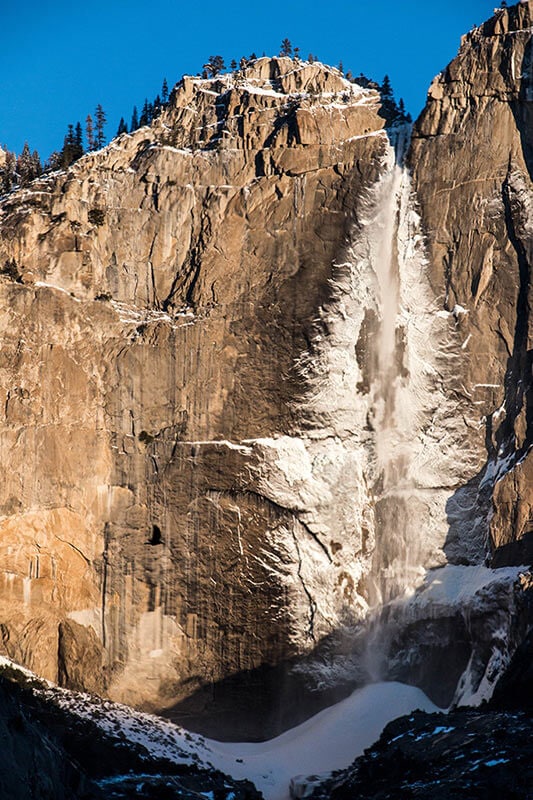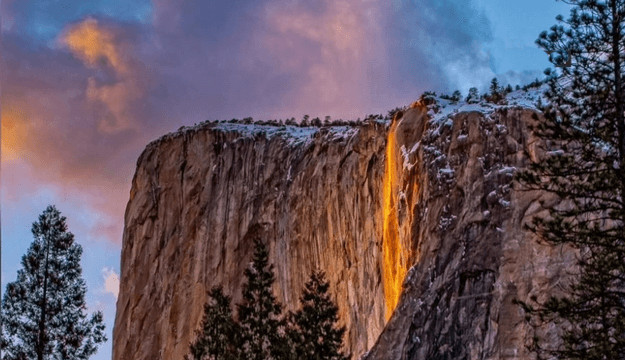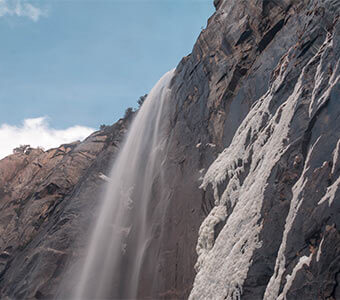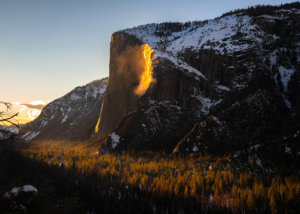Frazil ice. The very term conjures that pivotal moment when The Land Before Time became Ice Age. Buttercups froze on the tongues of mammoths and glaciers plowed through granite mountains to create, well, places like Yosemite Valley.
Unlike the movies, frazil ice is actually a real-life phenomenon that late winter/early spring visitors to Yosemite may be lucky enough to witness. Here’s a guide to experiencing one of the “cooler” natural phenomena on the planet.
What is Frazil Ice?
The frozen phenomenon of frazil ice happens when ice crystals collect in supercooled, turbulent water. In Yosemite National Park, it’s also a byproduct of frozen waterfall mist that reaches places like the Merced River. The Yosemite Nature Notes video above offers a great preview.
In Yosemite National Park, frazil ice is produced a couple of ways. Mist from Yosemite Falls can freeze in midair and tumble into free-flowing water below. Some of this frosty mist also collects on the sheer granite walls around the waterfalls. These chunks of ice eventually dislodge, plummeting into Yosemite Creek before flowing through the heart of Yosemite Valley, turning the Merced River into a slurry of ice. It looks a bit like slush, behaves like lava, and captivates all present.
Where Can I See Frazil Ice?

Yosemite Creek Bridge in Yosemite Valley is often the best (and safest) place to behold frazil ice. Frazil ice can also be seen at Ribbon Falls, Royal Arches Cascade, Bridalveil Falls and Salmon Creek. The flow is exciting and unpredictable, and can jump riverbanks with frozen fury, expanding the waterway beyond its former liquid state. Take care if you’re on hand for this mad frozen flurry; frazil ice may look like snowpack, but there’s the possibility of fast-moving water below the surface. Never venture too close to an active frazil ice flow.
When is the Best Time to See It?
The best chance to see frazil ice is late winter and early spring when there is relatively high flow over waterfalls and Yosemite Valley has overnight lows below freezing. March, April and May are prime time, when rivers rush with snowmelt. Frazil ice flows usually occur in the morning, before 9 am, but can occur at any time based on the air temperature.
Bonus Yosemite Valley Phenoms: Snow Cone and Firefall

Frazil ice is often accompanied by another phenomenon called the snow cone which occurs when falling water from Yosemite Falls freezes before it hits the ground and piles into a large cone of ice. The mound of snow and ice can reach hundreds of feet tall. It’s gravity serving as a natural Zamboni, piling up air-frozen waterfall mist and scraping ice off sheer granite walls all the way down to the base of upper Yosemite Fall. The ice falls alone are a sight, and sound to behold, as the cracking can sometimes be heard echoing through the valley as sheets come down off the walls.
As late winter turns towards spring, another natural phenom comes to Yosemite Valley ““ Firefall. For most of the year, Horsetail Fall is one of Yosemite’s more ephemeral waterfalls. Fed by a small stream tumbling over El Capitan, Horsetail Fall is fed entirely by snowmelt and evaporates by summer. But during the second half of February, the angle of the sunset “ignites” Horsetail Fall with fiery light that can appear to be liquid fire. The El Capitan Picnic Area is the best place to view Firefall.




